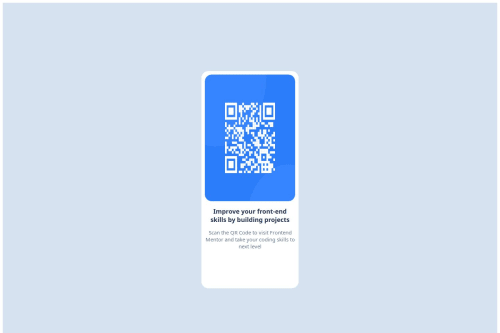QR Code to visit Frontend Mentor and start coding

Solution retrospective
Feedbacks are welcome
Please log in to post a comment
Log in with GitHubCommunity feedback
- P@DalaScript
Heey 👋
Here are some tips, I hope it helps:
HTML:
- In order for your website to be semantically justified, it is necessary to use semantic elements. Every web page needs a
<main>tag that separates the content. This is vital for accessibility as it helps screen readers identify the "main" section of the page. so change your<div class="mainContainer"></div>with<main></maintags. NOTE: - we don't use camelCase to identify html classes, instead we use hyphen mode, So the class would be correctly identified: main-container
- You also need to change the card tag with
<article class="card"></article>, instead of div. (A div is not a semantic element)
CSS:
- in this Challenge, you actually don't need to make it responsive, because sizes are the same for Mobile and Desktop.
- We first start writing the code for the mobile device, This is called - Mobile-first workflow.
- The rest depends on the dimensions, you just need to correctly specify the padding, margin, font size, font family and that's it.
Good Luck! DalaScript
Marked as helpful - In order for your website to be semantically justified, it is necessary to use semantic elements. Every web page needs a
- P@Stroudy
- Displays images with incorrect aspect ratio, Image display dimensions should match natural aspect ratio,
Aspect ratio (displayed) 190 x 200 (0.95) Aspect ratio (actual) 576 x 576 (1.00)Amazing job with this! You’re making fantastic progress. Here are some small tweaks that might take your solution to the next level…
-
This does not matter that much at this stage but something to be mindful of for SEO(Search Engine Optimisation),
<meta>description tag missing that helps search engine determine what the page is about, Something like this<meta name="description" content="" /> -
Using a
<main>tag inside the<body>of your HTML is a best practice because it clearly identifies the main content of your page. This helps with accessibility and improves how search engines understand your content. -
Using
max-width: 100%ormin-width: 100%is more responsive than justwidth: 100%because they allow elements to adjust better to different screen sizes. To learn more, check out this article: responsive-meaning. -
Developers should avoid using pixels (
px) because they are a fixed size and don't scale well on different devices. Instead, useremorem, which are relative units that adjust based on user settings, making your design more flexible, responsive, and accessible. For more information check out this, Why font-size must NEVER be in pixels or this video by Kevin Powell CSS em and rem explained.- Another great resource for px to rem converter. -
Using
remoremunits in@mediaqueries is better thanpxbecause they are relative units that adapt to user settings, like their preferred font size. This makes your design more responsive and accessible, ensuring it looks good on different devices and respects user preferences.
You’re doing fantastic! I hope these tips help you as you continue your coding journey. Stay curious and keep experimenting—every challenge is an opportunity to learn. Have fun, and keep coding with confidence! 🌟
Marked as helpful
Join our Discord community
Join thousands of Frontend Mentor community members taking the challenges, sharing resources, helping each other, and chatting about all things front-end!
Join our Discord